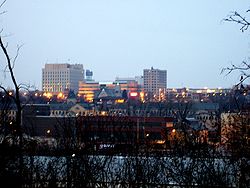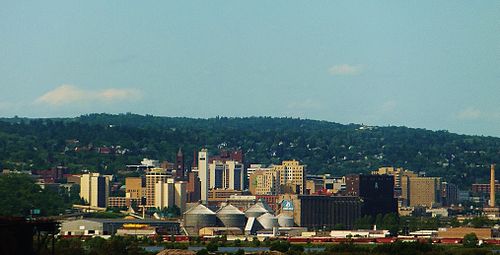Great Lakes megalopolis | ||
|---|---|---|
Major metropolitan areas of the Great Lakes megaregion (from top to bottom): Chicago, Toronto, Detroit–Windsor | ||
 Interactive Map of the Great Lakes Megaregion
| ||
| Countries |
| |
| States | ||
| Provinces | ||
| Largest city | Toronto (2,794,356) [1] | |
| Largest metropolitan area | Chicago metropolitan area (9,812,676) | |
| Population | ||
• Total | 59,100,000 | |
The Great Lakes megalopolis consists of a bi-national group of metropolitan areas in North America largely in the Great Lakes region. It extends from the Midwestern United States, and part of the Southern United States in the south and west to western Pennsylvania and Western New York in the Northeastern United States and northward through Southern Ontario into southwestern Quebec in Canada. It is the most populated and largest megalopolis in North America.
Contents
- History of the concept
- Governments
- Economy
- Education
- Major land and marine transportation corridors
- Chicago-Milwaukee-Minneapolis/St. Paul
- Chicago-St. Louis
- Chicago-Indianapolis-Cincinnati
- Chicago-Buffalo-Rochester
- Detroit-Chicago
- Windsor–Quebec City
- Secondary land or marine transportation corridors
- Kansas City–Pittsburgh
- Detroit–Grand Rapids
- Evansville–Indianapolis–Port Huron
- Cincinnati–Saginaw
- Duluth–Lake Huron
- Selected American and Canadian population centers
- See also
- Notes
- Gallery
- References
At its most inclusive, in the United States the region cuts a wide swath from the Twin Cities of Minneapolis–Saint Paul in Minnesota in the west, south to St. Louis and Louisville, Kentucky, and east to Rochester, New York; in Canada, it continues northeasterly to Quebec City. This broader region had an estimated population of 59,144,461 as of 2011 and is projected to reach a population of about 65 million by 2025. Within this broad region, there is a core area of more continual urban development that includes Chicago, Milwaukee, Grand Rapids, South Bend, Fort Wayne, Indianapolis, Detroit–Windsor, Cincinnati, Columbus, Cleveland, Toledo, Pittsburgh, Buffalo, Rochester, Toronto, Ottawa, Montreal, and the metropolitan areas between these.[ citation needed ]













